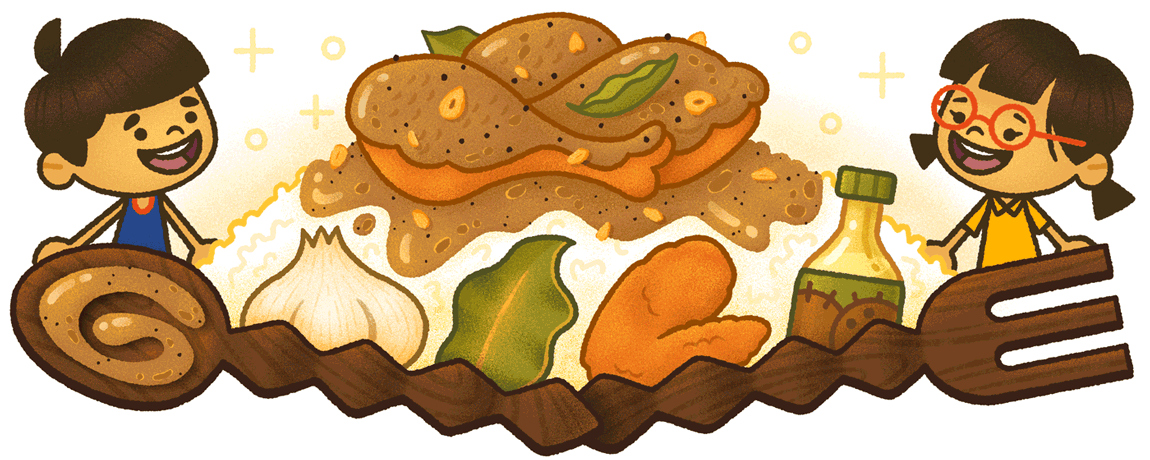
Mar 15, 2023
Celebrating Filipino Adobo
This Doodle’s Key Themes
Every bite is tender, juicy, and soulful. Today’s animated Doodle celebrates adobo, a way of cooking and a favorite Filipino dish! Adobo can be found far and wide, whether it’s at a five-star restaurant in Manila or inside the homes of Filipino families around the world. The word ‘adobo’ was first added to the Oxford English Dictionary (OED) in December 2006, and was included on the word list of the next OED quarterly update, released on this day in 2007.
There are many different kinds of adobo in the Philippines but they all share the same basic elements: marinated meat or vegetables braised into a stew. Common ingredients include vinegar, soy sauce, garlic, bay leaves, and black pepper. The local flavors make Filipino adobo much sweeter, sourer, and saltier in taste compared to other versions.
Several areas within the Philippines give their adobo a regional twist. Locals in Visayas enjoy adobong puti (white adobo), considered by some to be the original indigenous style, which exclusively uses vinegar without any soy sauce. In places like Southern Luzon, where coconut milk is a food staple, creamier adobo recipes like adobong manok sa gata (chicken adobo with coconut milk) are extremely popular. Others substitute meat with seafood like squid, or locally available vegetables like kangkong (water spinach) or sitaw (string beans).
After evolving throughout the centuries, this iconic dish is now enjoyed worldwide. It’s a symbol and expression of Filipino pride that varies from region to region, family to family, palate to palate. The history is rich, the taste is unmatched, and the aromas are enticing – the children in today’s artwork would definitely agree! Wherever and however it’s served, adobo leaves stomachs happy and mouths watering for more.
Today’s Doodle was illustrated by Doodle artist Anthony Irwin. Below, he shares his thoughts behind the making of this Doodle:
For children of immigrants, our relationship with our parents' food is a complex one. On one hand, my mother's cooking made me feel like I was exactly where I was supposed to be. It felt special and safe and warm. But on the other hand, most kids just want to fit in. Growing up in the U.S., I didn't want my food to be special. I didn't want to feel different. I just wanted to be like everyone else.
Now as an adult, I get to find all of these opportunities to be proud in ways childhood didn't let me feel proud. I can claim Filipino food as a part of my culture and celebrate the connection it creates between my mother's identity and my own.
I ordered some southern-style chicken adobo from a local restaurant to stir up some memories while working on the art for this Doodle, and the first thing that hit me was the smell. It was so bright and nostalgic, and instantly filled my apartment with that familiar feeling: this is exactly how things are supposed to be. So I tried to capture that simple childhood joy of leaning in and savoring the kind of food that makes home feel like home. Kain nang mabuti!
Where this Doodle appeared
Discover more Doodles by color
Did you know?
The very first Doodle launched as an “out of office” message of sorts when company founders Larry and Sergey went on vacation.
Learn MoreDid you know?
The first Doodle launched in 1998, before Google was officially incorporated.
Learn MoreDid you know?
The first same day Doodle was created in 2009 when water was discovered on the moon.
Learn MoreDid you know?
Doodle for Google student contest winners have gone on to become professional artists
Learn MoreDid you know?
The time it takes from sketch to launch for a Doodle varies widely: some have taken years and others just a few hours!
Learn MoreDid you know?
Hundreds of Doodles launch around the world every year. Often, several different ones are live in different places at the same time!
Learn MoreDid you know?
Our most frequently recurring Doodle character is Momo the Cat - named after a real-life team pet!
Learn More